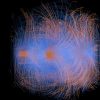Free Online Productivity Tools
i2Speak
i2Symbol
i2OCR
iTex2Img
iWeb2Print
iWeb2Shot
i2Type
iPdf2Split
iPdf2Merge
i2Bopomofo
i2Arabic
i2Style
i2Image
i2PDF
iLatex2Rtf
Sci2ools
VIS
2004
IEEE
2004
IEEE
Anisotropic Volume Rendering for Extremely Dense, Thin Line Data
Many large scale physics-based simulations which take place on PC clusters or supercomputers produce huge amounts of data including vector fields. While these vector data such as electromagnetic fields, fluid flow fields, or particle paths can be represented by lines, the sheer number of the lines overwhelms the memory and computation capability of a high-end PC used for visualization. Further, very dense or intertwined lines, rendered with traditional visualization techniques, can produce unintelligible results with unclear depth relationships between the lines and no sense of global structure. Our approach is to apply a lighting model to the lines and sample them into an anisotropic voxel representation based on spherical harmonics as a preprocessing step. Then we evaluate and render these voxels for a given view using traditional volume rendering. For extremely large line based datasets, conversion to anisotropic voxels reduces the overall storage and rendering for O(n) lines to O(...
Anisotropic Voxel Representation | Anisotropic Voxels | Intertwined Lines | VIS 2004 | Visualization |
| Added | 05 Nov 2009 |
| Updated | 05 Nov 2009 |
| Type | Conference |
| Year | 2004 |
| Where | VIS |
| Authors | Gregory L. Schussman, Kwan-Liu Ma |
Comments (0)

